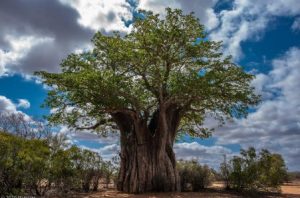(The boon-bestowing tree of life)
Common Name: Kalpvriksha, baobab, Gorakh Imli
Botanical Name: Adansonia digitata
Scientific Classification
Kingdom: Plantae
Order: Malvales
Family: Malvaceae
Genus: Adansonia
Species: digitata
Mythology
Kalpavriksha (Devanagari: lit:world tree-कल्पवृक्ष )
also known as kalpataru, kalpadruma or kalpapādapa, is a wish-fulfilling divine tree in Indian-origin
religions. It is a unique tree, a divine tree, a celestial tree, or a spiritual tree. Kalpavriksha, the tree of
life, also meaning “World Tree”. The tree has mythological link with prince Arjuna of the Pandava
clan who is said to have brought it from heaven. His mother Kunti after whom the village Kintoor is
named used to offer flowers from this tree to worship Lord Shiva.
Description
Adansonia digitata grow from 5–25 metres (16–82 feet) tall. The trunk is typically very broad and fluted
or cylindrical, often with a buttressed, spreading base. Trunks may reach a diameter of 10–14 m (33–
46 ft). The leaves are palmately compound with 5 to 7 (sometimes up to 9) leaflets in mature trees, but
seedlings and regenerating shoots may have simple leaves. Flowering occurs in both the dry and the wet
season. Buds are rounded with a cone-shaped tip. Flowers are showy and sometimes paired, but usually
produced singly at the end of a hanging stalk about 15–90 centimetres (6–35+1⁄2 inches) in length.
The calyx is typically made up of 5 (sometimes 3) green triangular bent-back lobes (sepals) with a
cream-coloured and hairy interior. The life of Kalpvriksha tree is 2000 years. Due to its appearance it is
sometimes also known as upside down tree. It is a very hardy tree and can survive in tough conditions.
Adansonia digitata commonly known as Kalpvriksha or baobab is one of the world’s largest trees
around.
Traditional Uses
The tree is named as: The small pharmacy or chemist tree for the reason that all parts like the
leaves, bark and fruits, seeds are used as foodstuffs and medicines. The specific documented uses
include the treatment of malaria, tuberculosis, fever, microbial infections, diarrhoea, anaemia,
dysentery, toothache etc.
Bioactive Compounds and Pharmacology
The presence of Polyphenol, tannin, flavonoids, procyanidin B2, vitamin C ̧ gallic acid and epicatechin
are found.It also contains an alkaloid ‘Adansonin’ which has been used for the treatment of fever
especially that is caused by malaria.


